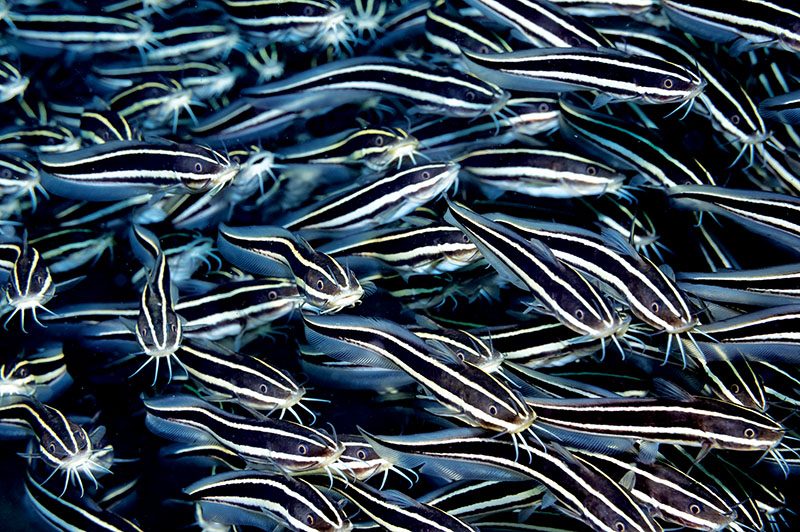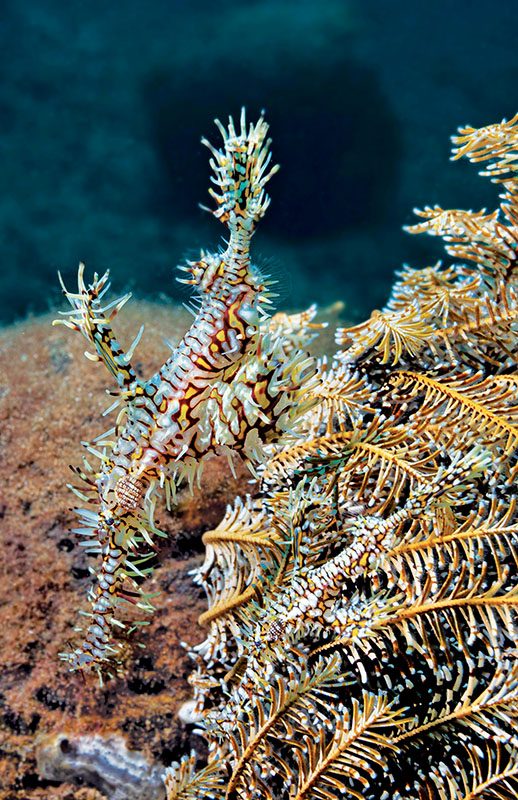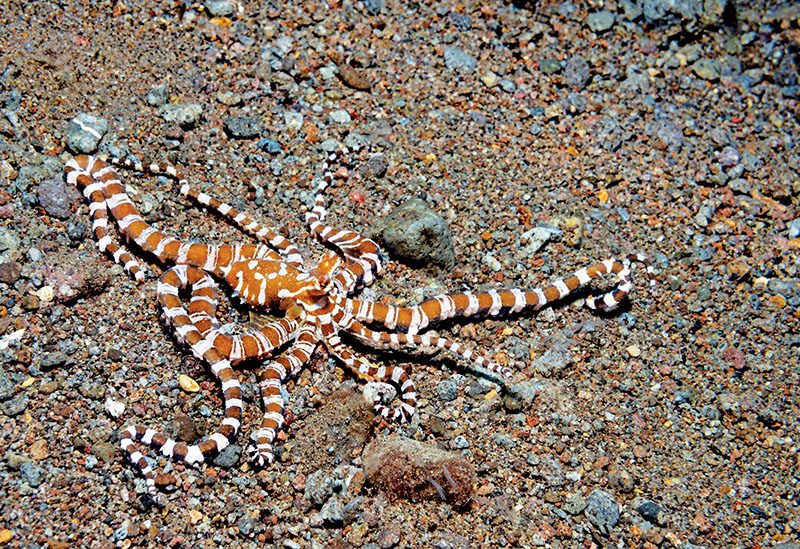Imagine yourself aboard a dive skiff on a tropical blue sea, getting ready to dive with legendary underwater photo pros Marty Snyderman and Michael Aw and extremely talented masters of the genre Tanya Griffin Houppermans and Vijay Raman. At some point and for one reason or another, most photographers have experienced the pressure to get the shot. You might expect we’d feel that pressure and a palpable undercurrent of competition as we geared up among such impressive company. During the time we spent with this amazing group, however, it just wasn’t so.
As underwater photographers increasingly share their watery realms with other equally passionate photographers, it’s understandable that some people might think underwater photo professionals are more determined to monopolize the best photo opportunities. But the reality is that any underwater photo pro worth their f-stops has learned to embrace the value of teamwork in the depths. That teamwork involves observing some guidelines we’ve experienced as the underwater photo etiquette that these pros demonstrate every time they are in the water.
Kolaborasi Versus Kompetisi
“Marine photography is just another form of photography, and if one learns more from what has been done before, on land or by the great artists, one can bring this underwater and create better images.”— Amos Nachoum
Sejak kami tiba di Filipina, tampak jelas bahwa semua orang mengecek ego mereka di pesawat. Semangat niat baik dan hubungan yang kuat di antara kontingen fotografer foto bawah air yang bertahan sepanjang perjalanan. Kami saling membantu satu sama lain untuk menemukan dan berbagi foto, bersosialisasi, dan bertukar pikiran mengenai perlengkapan dan teknik foto bawah air.
Kelimpahan atau Kelangkaan
“You will get all you want in life if you help enough other people get what they want.”— Zig Ziglar
Jika Anda memiliki pola pikir kelangkaan, Anda akan percaya bahwa hanya ada sedikit kesempatan untuk berfoto. Namun, ketika Anda membalikkan pemikiran tersebut untuk merangkul pola pikir kelimpahan, Anda akan segera menemukan bahwa selalu ada banyak kesempatan berfoto dan melihat kehidupan laut.

Berbagi Foto Ops
“Our goal is to capture seldom-seen behavior on film. And the trick to that is to simply spend huge amounts of time underwater.”— Howard and Michelle Hall
Limit yourself to five or six exposures if you or the dive guide locates a photogenic critter. If other photographers are waiting to take some photos of the same subject, slowly move away, position yourself down current, and be mindful not to silt up the scene as you depart. Take up a position and wait patiently for your next turn. If you want to capture a specific behavior, you shouldn’t let that desire make you rush your fellow photographers while they get their images.
Menghormati dan Melindungi Kehidupan Laut
“You must be a fish among fishes to study their surroundings and their life.”— Hans and Lotte Hass
Most photographers understand that harassing or manipulating marine life for image creation is unacceptable. Instead, they search for subjects that are in an appealing position, ideally with good negative space. Remember that your presence could put unnecessary stress on your subject. Photographers should consider limiting the number of pictures they take of any subject to protect them from multiple strobe bursts. Get the shots you’re after, and then move on.


Strategi Pendekatan Kehidupan Laut
“Get close safely. I call it predictive previsualization. See in your mind’s eye how the shot should look, set all your camera and strobe controls for when the creature gets close enough, and have the presence of mind to trip the shutter once you cohabitate the shot zone.”— Stephen Frink
When shooting marine life, adjust your camera as you think about how you will approach the subject. Move in slowly, preferably at an angle rather than head-on, and try to avoid triggering your subject’s fight-or-flight response. Casting a shadow or causing a pressure wave from your movement may startle a marine animal. If the reef terrain is relatively open, divers can spread out to cover more area and possibly find reef creatures that might otherwise have gone unnoticed.
Menjaga Kesadaran Situasional
“Building situational awareness is not done overnight, and it isn’t taught in any special course. Rather, it is something the individual diver must develop on their own. In many ways, it is the main difference between the good diver and the great diver.”— Thomas Grønfeldt Senger
When photographing a subject, be sure to routinely check what’s going on around you. Maintain situational awareness of your surroundings and whether any other photographers in the vicinity are setting up for a shot or shooting in your direction.
Endeavor to avoid swimming into another photographer’s field of view. Stay parallel or behind their camera when observing marine life or waiting for your turn to take images. Try to swim behind your fellow photographers instead of below them, so your exhalations don’t create unwanted bubbles in their scene.
A marine life pointing stick is a great underwater tool as long as you don’t allow yours to sneak its way into someone’s shot.
Beberapa fotografer bawah air menggunakan tendangan katak yang lembut alih-alih tendangan kepakan untuk menghindari pengadukan sedimen.

Patuhi Rencana Penyelaman
“Find a group of people who challenge and inspire you, spend a lot of time with them, and it will change your life forever.”— Amy Poehler
It seemingly happens all the time: You’re near the end of your dive, and you discover a primo subject minutes before the dive plan calls for everyone to surface. It’s incumbent upon everyone to end their dive at the agreed-upon time. It’s disrespectful to be late and keep others waiting topside. After all, they may have places to be, lunch may be waiting, or they may need some additional surface interval time to troubleshoot a camera system malfunction.
Show some respect by sticking to the dive plan, so you don’t affect others in your group. If you can’t respect others by adhering to the agreed-upon dive plan, consider hiring a private dive guide and boat.
Simpati untuk Pemandu Selam
“Yes, I get by with a little help from my friends.”— The Beatles
Nobody works harder or feels more pressure to help underwater photographers get the shot than dive guides. Don’t monopolize them; they should be free to share their unique talents among your fellow underwater photographers. Be kind, courteous, and respectful, and let them work their magic. They will help you capture images of rare or elusive marine life. If you’re happy with their services, show your appreciation by leaving a generous gratuity, giving them a shout-out in a review, telling their boss, and recommending them to your photographer friends.
Kerja Sama Tim Mewujudkan Impian
“The strength of the team is each individual member. The strength of each member is the team.”— Phil Jackson
People are more likely to be successful working as a team than competing as individuals. Whenever you have a group of peers with high levels of trust coupled with a desire for respectful relationships, you’ll truly understand how teamwork makes the dream work. Embracing this thinking makes it possible to be a good ocean citizen during your pursuits to get the shot.
© Penyelam Siaga - Q1 2023